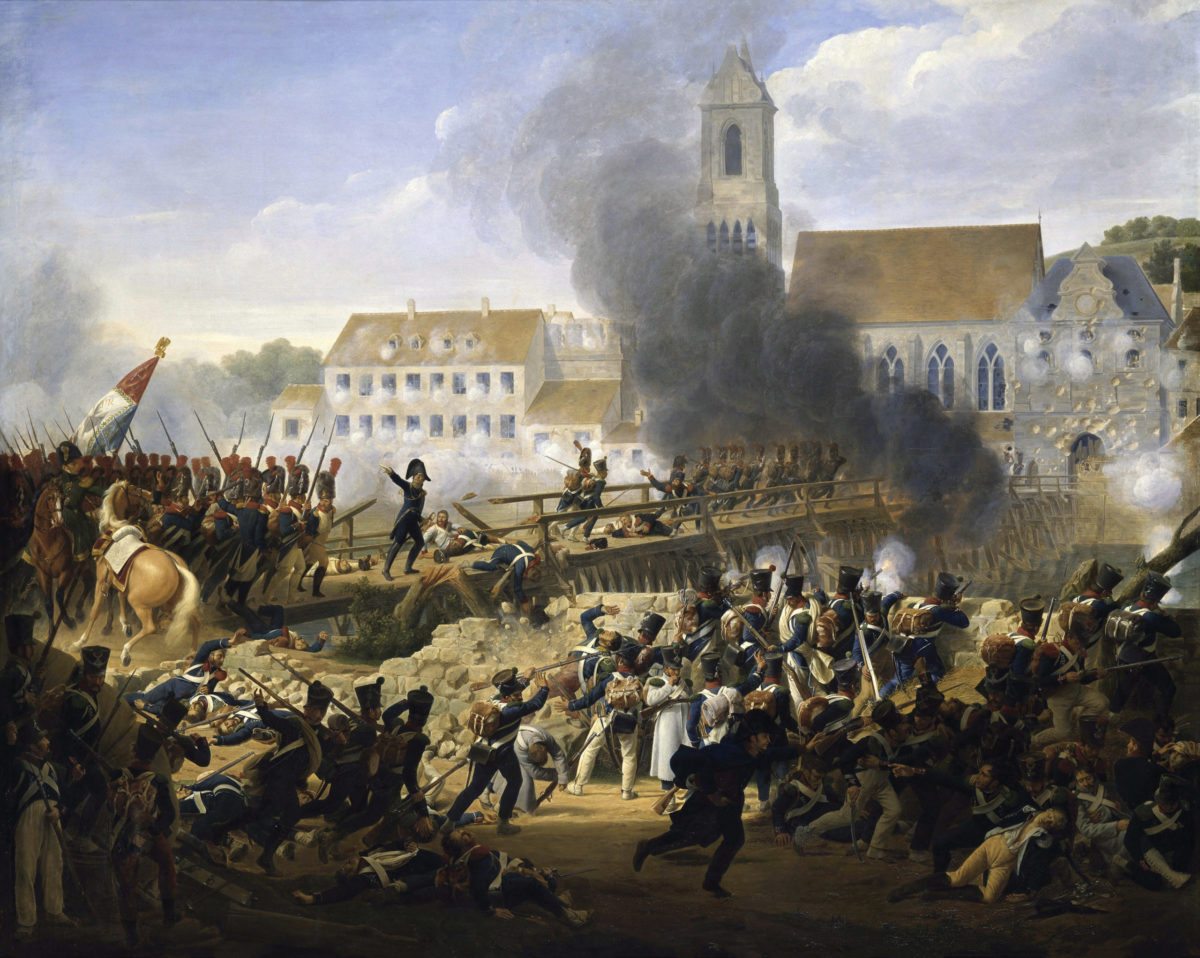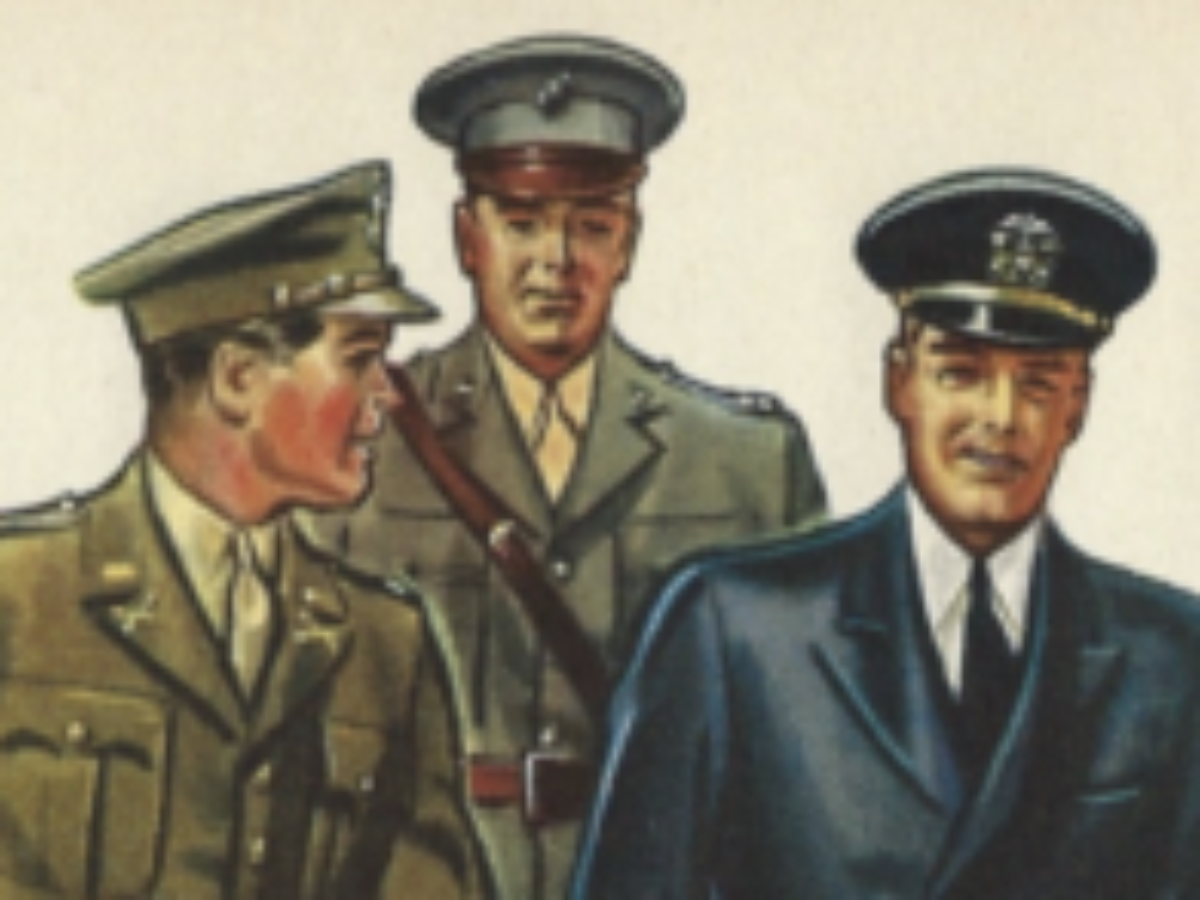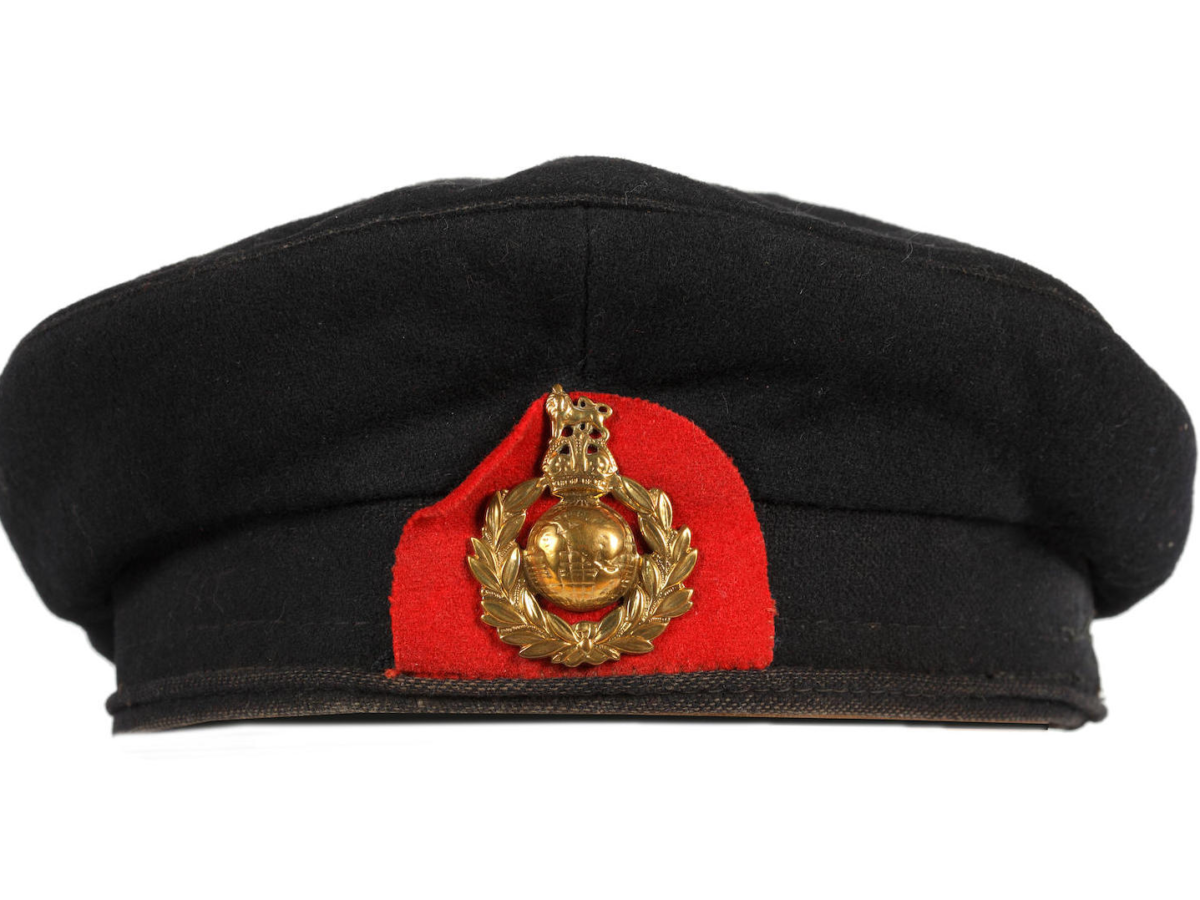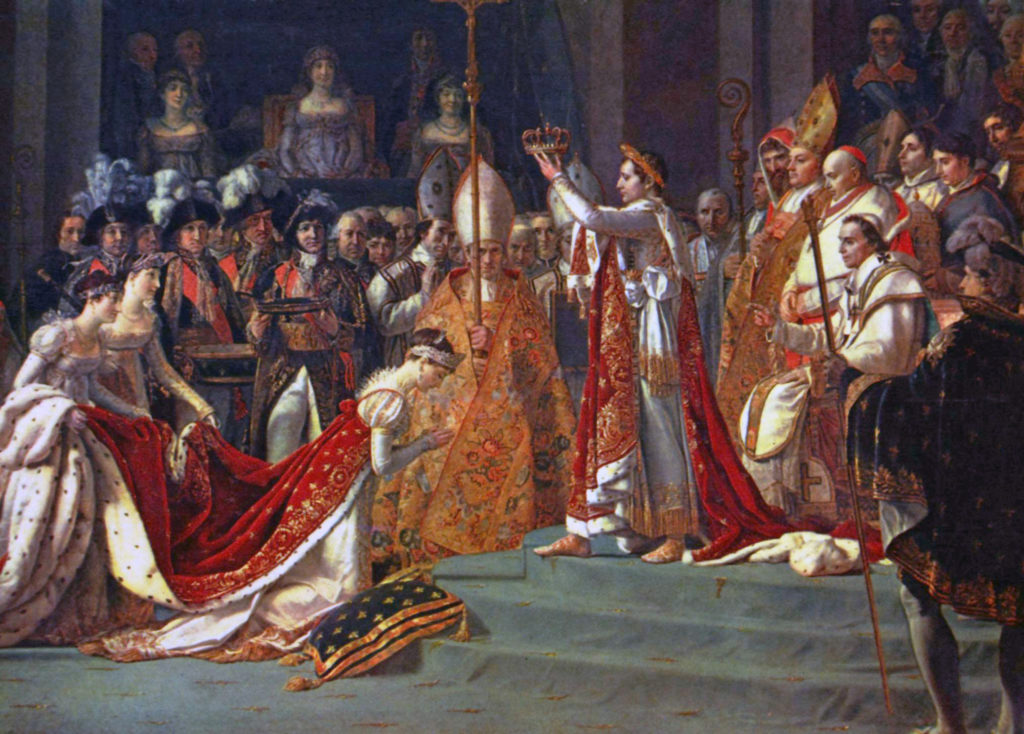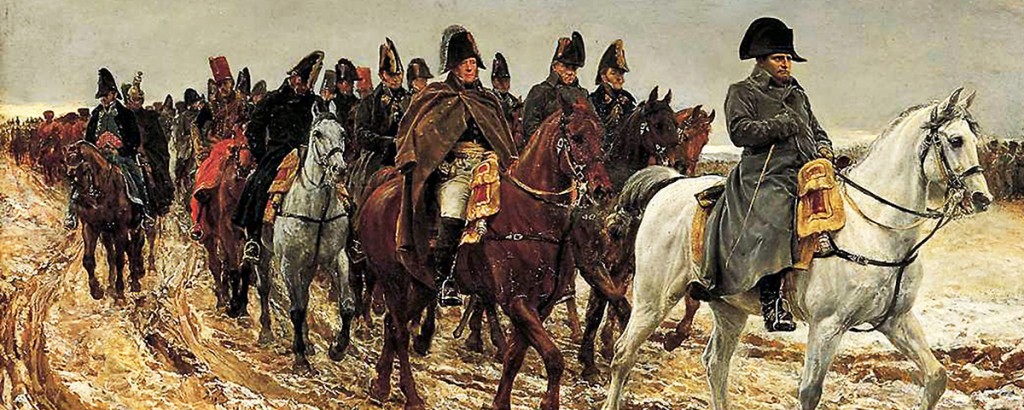What was life like for infantrymen during the Napoleonic Wars? Imagine, if you will, two different soldiers of those days: a British fusilier in 1808 and a French light infantryman in 1812. Their uniforms, equipment and weapons differ, as do their languages and personal appearances. Yet there are still some things that they have in common. The summer heat is a factor for each of them: the fusilier in Spain as well as the light infantryman in Russia as he marches toward the Battle of Borodino. Each man is sweating profusely. The straps of his pack are too thin, or the pack is too heavy for the straps, or the load improperly adjusted. Whatever the reason, weight is a constant physical presence that alternates between causing stabbing pain in the shoulders and a crushing ache in the lower back. Their individual weapons are muzzle-heavy and imbalanced, adding more weight to their already overladen shoulders.
These men are chafed, blistered, filthy, exhausted, and smell very bad considering that they haven’t bathed in weeks. Each is tired, but that doesn’t even begin to describe the level of their exhaustion. Both are so dehydrated that pounding headaches hammer behind their eyes, and they feel sick—either because they are just recovering from a bout of dysenteric diarrhea, or because they are coming down with one.
They don’t know if their illness is caused by bad food, bad water, or both—and knowing wouldn’t make any difference. Their feet hurt due to poorly fitted shoes which are heavy and inflexible if not literally falling apart. These infantrymen on the march put one weary foot in front of the other for mile after seemingly endless mile—but they were the toughest men of their day, and this was just part and parcel of soldiering.
When Fashion Trumped Function
Terrain, weather, and distance have always contributed to the exhausting misery that is part of infantry life in every era and war, but the things with which soldiers are laden also play a part. In the Napoleonic era, just as today, infantrymen of most armies were overloaded with a staggering amount of military equipment. Some gear was necessary and some not, at least in the opinions of the men who had to carry it.
Rfn. Benjamin Harris, who survived the grueling winter retreat to Coruna in 1809, described the British infantryman’s load as being almost more than a man could manage in those conditions. Some men could not manage and perished as a result. “The weight I toiled under was tremendous…,” he wrote, “indeed, I am convinced that many of our infantry sank and died under the weight of their knapsacks alone. For my own part… I marched under a weight sufficient to impede the free motions of a donkey…”
By his own admission, Harris was no imposing physical specimen. “Altogether the quantity of things I had on my shoulders was enough and more than enough for my wants, sufficient, indeed, to sink a little fellow of five feet seven inches into the earth.”
It was not only the sheer weight involved that proved a problem. In those times, long before the concept of ergonomics was ever applied to the design of military loadbearing equipment, infantrymen suffered from poorly arranged loads. “Nay, so awkwardly was the load our men bore in those days placed upon their backs,” Harris wrote, “that the free motion of the body was impeded, the head held down from the pile at the back of the neck, and the soldier half beaten before he came to the scratch.”
Additionally, the most battle-tested armies of that era went into action dressed in a manner completely unsuited to the hard job of soldiering in the field. Yet the impracticality of military uniforms was not the result of a lack of experience in the physical demands of soldiering. Tradition mattered more than soldiers’ comfort, and fashion usually won over function.
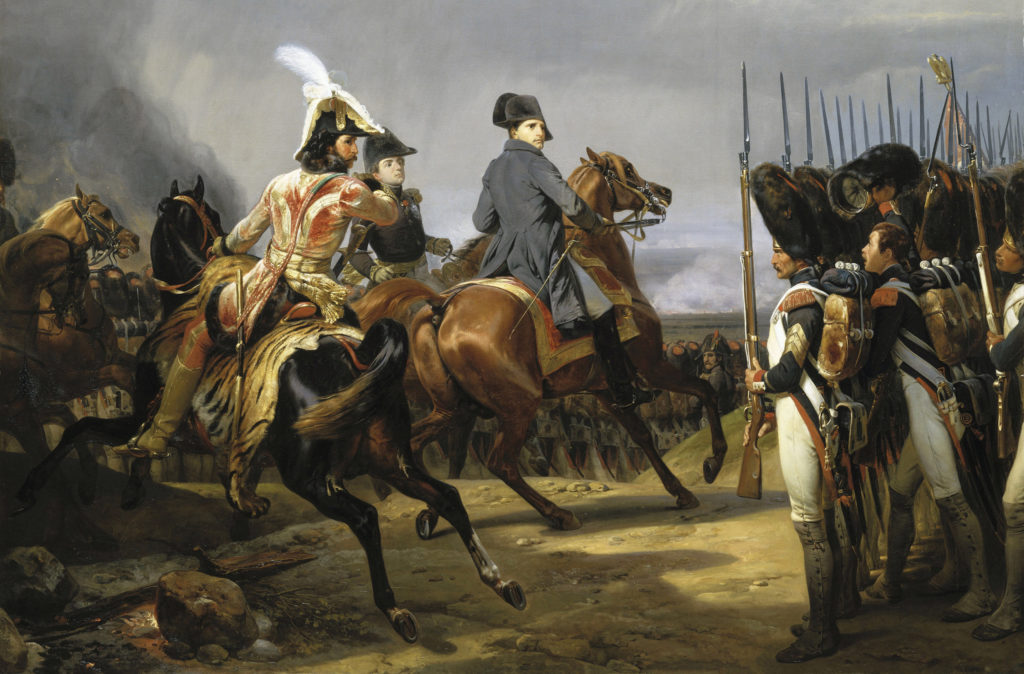
Blaze de Blury was a lieutenant in the Grande Armee that marched into Russia in 1812. After the horrific retreat that destroyed most of that army and Napoleon’s ambitions with it, de Blury was lucky to still be alive to record his experience. “I have never understood,” he later wrote, “why under Napoleon, when we were constantly at war, the soldier should have been forced to wear the ghastly breeches, which, by pressing on the hams at the back of the knee, prevented him from walking easily. On top of that, the knee, which was covered by a long buttoned-up gaiter, was further strangled…”
Recommended for you
This was the uniform of an infantry that walked everywhere across Europe. “It was, all in all,” de Blury concluded, “a conspiracy by three thicknesses of cloth, two rows of buttons one on top of the other, and three garters to paralyze the efforts of the bravest of marchers.” Impractical uniforms were not a problem for the French alone. To varying degrees every army of the period outfitted their infantry in clothing that ranged from the poorly designed to the downright absurd.
The Myths of Napoleonic Musketry
At least one ungainly piece of the infantryman’s combat load was indispensable, and that was his weapon. It might be tempting to dismiss the Napoleonic soldier’s musket as a rather simplistic weapon. After all, it was a single-shot, smooth-bore, muzzle-loading black powder firearm with incredibly primitive sights. Using it effectively was as much a matter of discipline acquired from experience as understanding how to best shoot within its limitations. It was essentially a heavy and crude point-and-shoot weapon. If firing it was a simple matter, the loading and reloading sequences were not. For French infantrymen in 1815, the musketry drill consisted of eight basic steps in loading their pieces. The British drill of the same period required 10 steps. This had a predictable effect on rates of fire.
In the chaos and smoke of massed infantry combat, a veteran unit of well-trained infantry might be able to achieve a sustained rate of fire of only three to four rounds a minute. The British—one of the only armies in the world to regularly train their infantry with live ammunition—could consistently put out rates of fire slightly better than that, but were also limited by the inefficiency of their weapons.
The image one sometimes encounters in film and fiction of a Napoleonic-era soldier biting open a paper cartridge and holding a ball in his mouth before pouring in the powder and spitting it down the barrel is probably inaccurate. After firing just a few rounds, the muzzle of the musket was hot enough to blister skin on contact.
Accuracy with these weapons was notable for its almost complete absence. When it came to infantry firepower, all Napoleonic armies stressed quantity over quality—that is, as much massed fire as possible.
This was where discipline came into play. To maximize the effect of musketry, it was necessary for infantry to stand firm and wait until the enemy advanced perilously close before unleashing the critical first volley. In 1814, the noted British ordnance expert Maj. George Hanger wrote, “A soldier’s musket, if not exceedingly ill-bored (as many are), will strike a figure of a man at 80 yards; it may even at a hundred; but a soldier must be very unfortunate indeed who shall be wounded by a common musket at 150 yards, providing his antagonist aims at him; and as to firing at a man at 200 yards with a common musket, you may as well fire at the moon and have the same hope of hitting him.”
Hanger was an absolute realist about the standard musket’s problems with accuracy.
“I do maintain and will prove,” he wrote, “that no man was ever killed at 200 yards, by a common musket, by the person who aimed at him.”
Marksmanship doctrine of the day could be summed up simply: level your piece in the general direction of the enemy’s ranks, let fly, and hope for the best.
Wild Firing And Skirmishing
There were a few exceptions. The riflemen of the British Army’s 95th Rifles were consistently able to hit targets out to much greater ranges as the result of both better training and their specialized weapon, the Baker rifle. Aside from the obvious advantage of having a rifled bore, the Baker also benefited from using spherical, leather-patched ball ammunition that fit tightly in the barrel to give the ball a ballistic spin when fired. This greater accuracy came at the cost of a lower rate of fire—the Baker rifle took considerably longer to reload than a standard-issue smooth-bore musket. Thus rifle companies usually filled the skirmisher role.
The Baker rifle had a bladed sword bayonet, but the British Brown Bess and the French Charleville muskets used socket bayonets when closing with the enemy battle line. Mass firing by opposing forces ranks was merely a prelude to the bayonet attack.
Firing volleys was to soften up one’s opponent. This remained the standard infantry attack tactic until the American Civil War when the new, rifled musket essentially reduced the bayonet to a “cooking utensil.”
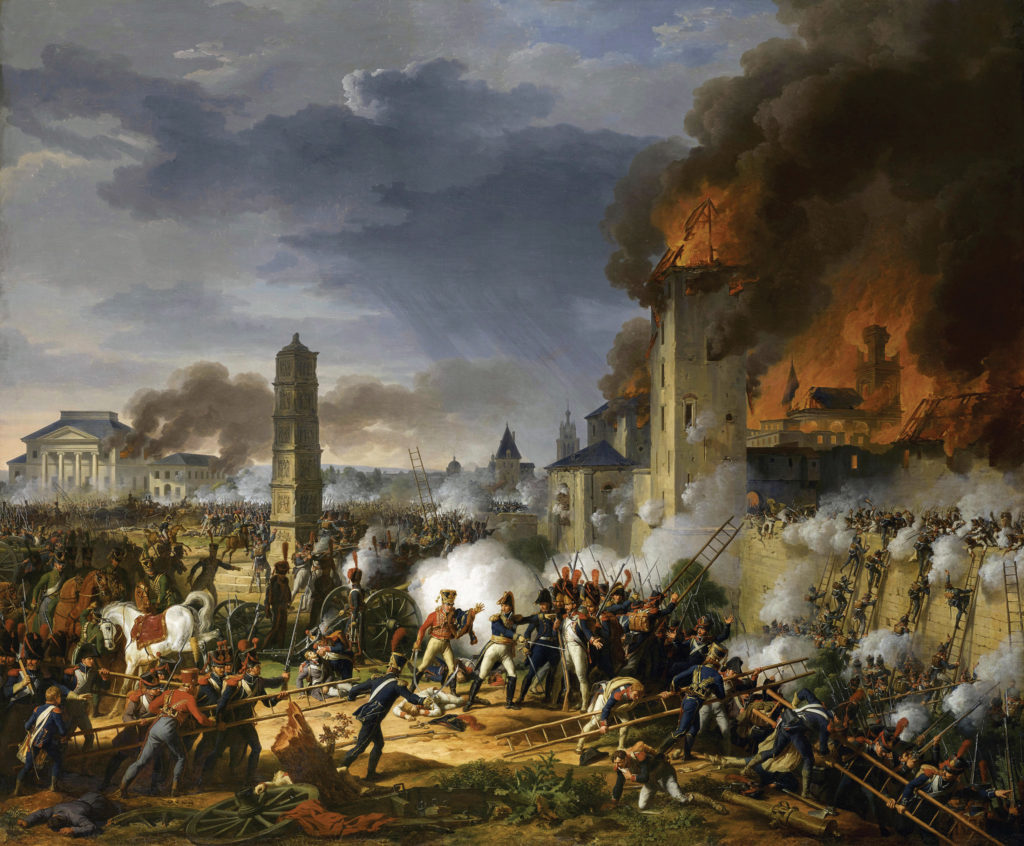
This reduced rate of fire ironically prompted Napoleon Bonaparte to decide against issuing rifled muskets to the voltigeurs, the light skirmishers of the French army—a decision which put them at a considerable disadvantage when they faced British riflemen. Another factor in the French decision to arm all infantry with standard muskets may have been a desire to retain a measure of flexibility in their combat role.
All French infantry trained as skirmishers. Under French doctrine, a battalion of conventional infantry was expected to be able to deploy as skirmishers on command, then regroup into a column or line of battle as the tactical situation required. As one historian notes, “only the French can lay claim to the universal employment of their line infantry as skirmishers.”
Depending on the army in which they served, regular infantry in the line and grenadier regiments of the Napoleonic Wars were armed with the British Land Pattern Tower musket (the famous Brown Bess), or the French Model 1777 musket, the New Prussian Model 1809, or the Austrian Model 1798. Accuracy was not an option for any of these weapons. There were no aiming sights to speak of— just a small rectangular bayonet lug on top of the barrel near the muzzle which served as a primitive front sight.
Unlike the Baker rifle, standard infantry muskets were loaded with balls that were loose in the barrel and which would rattle around if not rammed down with wadding (the paper “cartridge” containing loose powder and the musket ball).
How British Training Foiled the French
Ammunition was the other integral part of the weapons system. A soldier could have the finest firearm ever designed, but once he ran out of ammunition it was little better than a club or a spear with the bayonet. The amount of ammunition soldiers carried varied considerably depending on the army and the soldier’s individual role, but those small, lethal cartridges of gunpowder and lead were crucial to his ability to stand and fight. No matter what else a soldier might throw away to lighten his load, the basic load of ammunition was not casually discarded. Skirmishers, operating independently, often used ammunition at a faster rate than battalions firing in command volleys.
For armies of the Napoleonic Wars, individual rounds of ammunition were issued in cartridge form, made of paper (tough, but not waterproof) which contained a lead ball and about 150 grains of loose black powder. The quality of the powder varied greatly, depending on the manufacturer. In the 95th Rifles, where individual marksmanship mattered as a professional skill, soldiers used a higher grade of powder for their rifles. When they had to settle for inferior stocks of standard-issue gunpowder, they ground down the grains to a finer strain themselves in order to improve the ballistic performance of their shots.
Other skills were essential to a soldier of that era, and most required more than just the physical conditioning of route marching or the repetition of parade-ground drilling. The fulfillment of the infantry’s role as the sharp end of the army’s spear always came down to the individual soldier’s skill in musketry—in other words, his ability to put rounds downrange as rapidly as possible, usually while under fire.
Marksmanship training, as rudimentary as it was, received lesser or greater emphasis in different armies and sometimes came perilously close to being neglected altogether. When the marching stopped and the fighting started, musketry was always the infantry’s essential technical skill.
Resilience, discipline, and courage could make all the difference in the fight.
An ability to stand firm while torn by the enemy’s fire, waiting for the crucial moment, sometimes without being able to return fire, was the factor that determined the outcome on battlefields from Austerlitz to Salamanca.
The British fielded what were probably the best-trained infantry formations in their day, at least in terms of their battle drill in musketry. Forming double lines of infantrymen firing in alternating volleys gave them a huge advantage in the amount of firepower they could bring to bear across their linear front. To achieve this in battle, the British drilled their infantry regiments with a single-minded intensity.
Crammed Columns, Poor Visibility
All armies of the day used multiple ranks of alternating fire in their linear formations, but what made British musketry so effective was the fact that British infantry fired live ball ammunition in training. Remarkably, few other armies of that era did so. That may have had something to do with economic realities—“a single round,” as one historian notes, “cost at that time almost as much as food for a full day…”
Other armies recognized the combat value of British training but could not hope to equal it. The Prussians, known for having a first-rate army in most respects, “pointed out that their own troops, even in three-deep lines, did not have the discipline, training and individual stability to hold such formations and didn’t try to use them.”
In contrast, the French army usually advanced its infantry in massed columns, bringing the physical force of the columns to bear on an enemy’s static position which was seldom as deep, front to back. Napoleon used a “combined arms” approach—infantry and artillery—with the infantry advancing in powerful columns and then light artillery pieces brought up to literally blast holes in the enemy line. Infantry advancing in line were more apt to be thrown into disorder by terrain or obstacles, particularly if they were inexperienced or poorly trained.
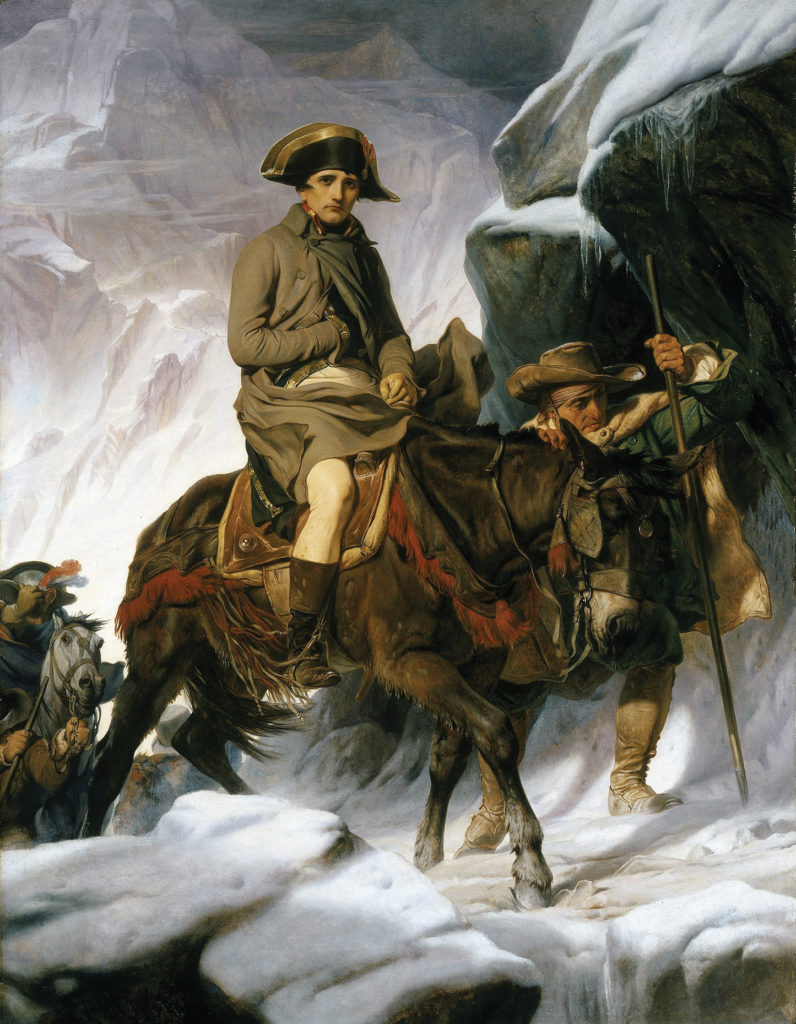
For French brigades, advancing in column was often simply the best option. Gen. Antoine-Henri Jomini, drawing on a wealth of experience in his observations, once remarked, “The French, particularly, have never been able to march steadily in deployed lines,” so the column was the standard formation in the assault. It was the principle of the battering ram against the wall. As a tactic it worked for the French time and again against armies all over Europe.
It did not always work well against the fearsome musketry of well-led British infantry. In battle after battle in the Peninsular War, the British demonstrated that a wide front of highly trained, well-disciplined infantrymen standing their ground while firing one crashing volley after another in quick succession almost always trumped the more visually intimidating bulk of a brigade in column.
Sustained infantry combat was hard on both men and weapons. The anonymous British narrator from the 71st Regiment, remembering the savage fighting at Fuentes de Oñoro in 1811 in the Peninsular War, said that by the time that day’s battle was ended, “My shoulder was as black as coal, from the recoil of my musket…”. He had fired 107 rounds of ball cartridge that day—nearly all the ammunition he had. French soldiers also found the experience of toe-to-toe infantry combat exhausting.
Jean-Roch Coignet, fighting the Austrians in 1800, later wrote, “Their columns were constantly reinforced; no one came to our support. Our musket-barrels were so hot that it became impossible to load for fear of igniting the cartridges. There was nothing for it but to piss into the barrels to cool them, and then to dry them by pouring in loose powder and setting it alight unrammed.”
Nineteenth century infantry battle was a comparatively short-range affair, but even so an individual soldier’s view of the fight was often limited. More than one soldier commented that, in the hottest part of the brawl, dense clouds of white smoke made it all but impossible for infantrymen to see ahead or nearby. Seeing action across the field was even less likely.
As a British veteran wrote in his account of the fighting at Waterloo, “The noise and smoke were dreadful. At this time I could see but a very little way from me, but all around the wounded and slain lay very thick.”
Harris described much the same experience. “I myself was very soon so hotly engaged,” he wrote, “loading and firing away, enveloped in the smoke that I created, and the cloud which hung about me from the continued fire of my comrades that I could see nothing for a few minutes but the red flash of my own piece amongst the white vapour clinging to my very clothes…” A soldier’s world narrowed around him in those conditions. “Until some friendly breeze of wind clears the space around,” he wrote, “a soldier knows no more of his position and what is about to happen to his front, or what has happened (even amongst his own comrades) than the very dead lying around.”
The Proof At Waterloo
The Battle of Waterloo was a ferocious test of military discipline for the British soldiers holding their positions. French cannon fire ripped bloody swaths through their ranks. Time and time again the British regulars obeyed the orders of their officers and NCOs to close the gaps over the bodies of their fallen comrades. They had to stand fast, firing volley after volley into the French that came up against them, maintaining the massed formations that were necessary to ward off the French cavalry that repeatedly tried and failed to break their squares. As the day wore on and their casualties mounted, even that iron discipline began to waver.
Infantry in square presented splendid targets for artillery, and every time the French cavalry fell back, the supporting French batteries blasted killing sweeps of round shot (and canister, when the range was short enough) through the British formations. Had it not been for Wellington’s reverse-slope position sheltering his infantry from the worst effects of the French gunnery, it is fair to wonder if the British infantry could have held their ground under such sustained, direct artillery fire.
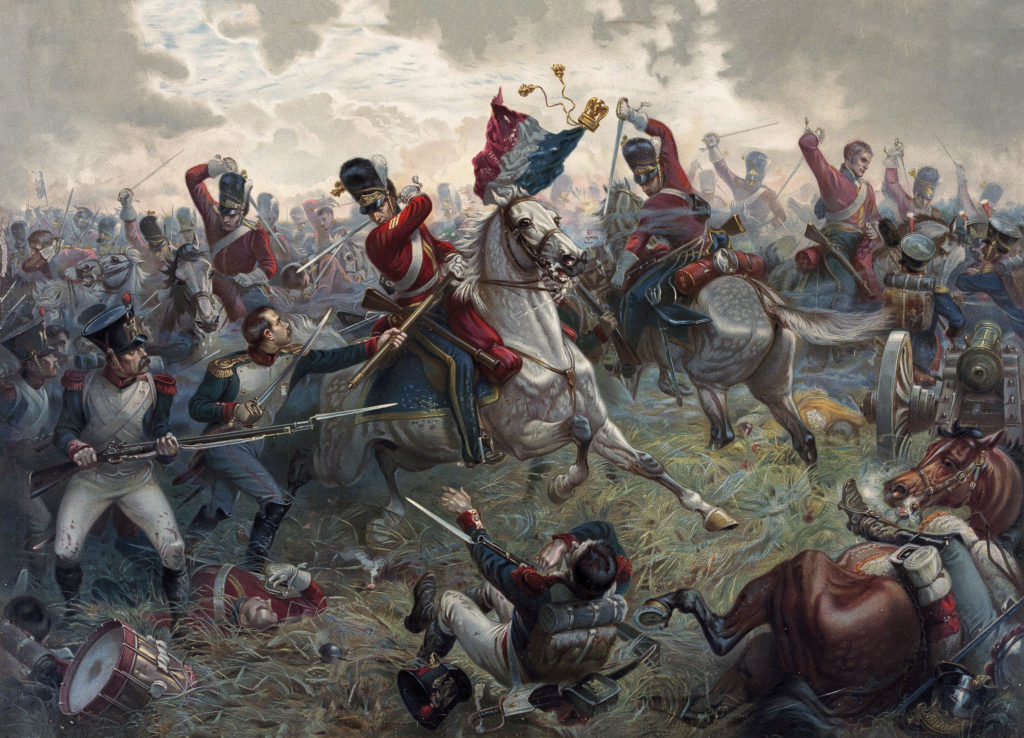
The British ability to stand firm owed to discipline and personal leadership. Thomas Morris, who fought at Waterloo with the 73rd Regiment, described a moment where an officer’s personal example was the vital antidote to the fear spreading through his regiment.
“Once, and only once, during the dreadful carnage at Waterloo,” Morris wrote, “did the stern Seventy-Third hesitate to fill up a gap which the relentless iron had torn in their square; their Lieut.-Colonel (Brevet Colonel Harris) at once pushing his horse lengthwise across the space, said with a smile, ‘Well, my lads, if you won’t, I must;’ it is almost needless to add that immediately he was led back to his proper place, and the ranks closed up by men still more devoted than before.”
Wellington famously remarked that Waterloo was “the nearest run thing you ever saw in your life.” He was not a man given to exaggeration or hyperbole. Even some of the hardened veterans in the British ranks thought it was one of the toughest fights they had seen. Morris wrote that his sergeant-major was “a brave soldier, and had been through the whole of the engagements in the Peninsula,” but Waterloo proved beyond even his considerable experience.
In the worst part of the day at Waterloo, as casualties mounted and the British ranks were being torn apart, the sergeant-major told his colonel, “We had nothing like this in Spain, sir.” The sergeant major was deathly pale when he said it, and his use of profanity increased as the battle went on in a sure sign of his stress.
All these factors—hard marching in impractical uniforms, cumbersome weapons and repetitious drill, as well as the chaos and carnage of battle—comprised an infantryman’s life during the 12-year span of the Napoleonic Wars. Whether fighting for the British, French, or any of the other nations that made up the shifting alliances of the day, soldiers of all armies on battlefields from Spain to Russia shared the same grim view from the infantry’s ranks.

